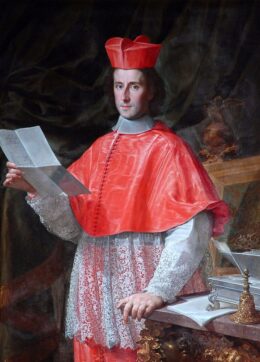
Printed
80 pages
Author(s)
Teodosio il Giovane
In 1708, Ottoboni has a magnificent theatre built in his Palace of the Chancellery. Designed by Juvarra and Pellegrini, the theatre comes with one hundred and twenty-seven sceneries. Ottoboni staged Il Costantino pio in his “teatrino ad uso di pupazzi”, at the beginning of the theatrical season in 1710; the following year, he gave Teodosio il Giovane. According to testimonies, the very expensive puppets were “almost four feet high” and made of cardboard or wood; they closely resembled human actors. They were moved on wooden runners and manipulated from below the stage, using a counterbalance system. The music was composed by Filippo Amadei; the illustrations in the libretto give a sense of what Juvarra’s sceneries looked like: spectacular on an architectural level, they bring the audience to the seaside, at the walls of Constantinople, or again in Teodosio’s (Theodosius') library.
The plot of Teodosio il Giovane builds on an historiographical account of Imperial Rome to relate a romantic conflict between the Emperor of Orient, Teodosio, and the king of Persia, Varane. Still under the authority of his sister Pulcheria, Teodosio must learn the ways of a good government, somehow like Corneille’s Cinna. The tone is as edifying as it is spectacular: the final machine, which was highly praised by contemporaries of the play, represents the kingdom of Wisdom, taking Eudocia to meet her husband before their wedding. The dances are performed next to a fountain or in the library, by characters and ghosts that went through surprising transformations provoked by the magician Acrisia. Other spectacular scenes testify to the technical virtuosity of the machines used in Ottoboni’s teatrino, most particularly the landing of Marciano’s army, accompanied by a procession of prisoners at the end of act I; the lesson of astrology given to Eridione, who is taken into the sky in the second act; or the removal of Teodosio’s statue during the third act.
An emperor overcomes his jealousy
Teodosio (Theodosius, Emperor of Constantinople) welcomes Marciano’s army. Marciano is returning victorious from the Persian Empire, and he is bringing back Ariene, the fiancée of Varane (king of Persia). Teodosio asks that Ariene be released, and he offers her peace; but the Queen is too proud. Atenaide, a young Greek woman devoted to philosophy, hesitates between coming back to Athens and staying with the Emperor: although she loves him, she fears that their respective statuses are too different. Varane arrives at court in disguise. He befriends Atenaide and expresses jealousy at Teodosio being generous with his wife. Pulcheria welcomes Marciano, whom she loves. Teodosio is jealous of Atenaide and Varane. When Teodosio accepts Ariene’s gift—she gave him fruit to thank him for his generosity—Varane, who is watching them, believes that they are having an affair. Atenaide believes so too. To reassure Atenaide, Teodosio gives her the fruit, which she gives Varane in turn, since the stranger insisted on it. Atenaide’s companion, Acrisia, reveals to Eridione, Ariene’s servant, a miraculous fountain that changes into a dragon. She gives him a dance lesson, which introduces the interlude.
Marciano is watching out for Varane on the shore. He witnesses Varane and Ariene reuniting. Since Marciano wishes to catch his enemy, whom he has recognised, the Queen steps in to protect her husband. But Varane orders her to leave. After refusing Marciano’s peace proposal, Varane is defeated. Teodosio offers peace again; Varane rejects it another time. As the Emperor is reading Costantino’s story in the library, Ariene arrives. Atenaide watches them with jealousy. Ariene and Teodosio believe that their lovers have betrayed them. Finally convinced that Teodosio loves her, Atenaide is also suspected of unfaithfulness, since she cannot give back the fruit which her husband gifted her. Atenaide manages to convince Ariene of Varane’s faithfulness; and Acrisia promises to fix the situation. She makes four pages appear in the library, then she gives Eridione an astrology lesson; Eridione is taken into the air on a cloud. The tables of the library change into nymphs; they begin to dance.
Pulcheria reproaches her brother for his unchristian jealousy, and commands him to stop seeing Atenaide. Ariene and Varane reconcile and knock down Teodosio’s statue. The Emperor dismisses Atenaide. He hesitates over putting his enemy to death, but eventually decides to be consistent: he spares Varane’s life and offers him a throne. Faced with such generosity, Varane is vanquished. Teodosio’ wedding is being prepared. Teodosio despairs at the thought of never seeing Atenaide again. Pulcheria summons the new bride, who turns out to be Atenaide calling herself Eudocia. The Emperor and the young Greek woman celebrate their wedding at the same time as Pulcheria and Marciano.
First performance
Palazzo della Cancelleria
Publications and translations
Teodosio il Giovane. Roma: Antonio de'Rossi, 1711.
Nicola Badolato, "All'occhio, all'udito ed al pensiero", Gli allestimenti operistici romani di Filippo Juvarra per Pietro Ottoboni e Maria Casimira di Polonia. Torino: Fondazione 1563 per l’Arte e la Cultura della Compagnia di San Paolo, 2016.
